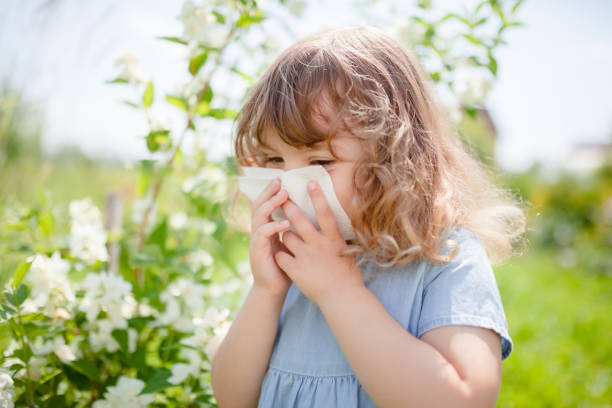If you have a child with allergies, you may have wondered just what triggers allergies in a person and what the underlying causes really are. Allergies are actually a very complicated subject that involves many of the body’s most important functions. They come from some of the most complex systems in the human body, and in some ways are a good sign! In this post, the ScratchMeNot team would like to share some points about what allergies are, what causes them, and why your child has allergies at all.
What Are Allergies?
The immune system helps our bodies recognize and fight unwanted things in our bodies like foreign matter, bacteria, viruses, and other problems. Allergies are a sign that your child’s immune system is overactive and that it ‘attacks’ things that actually pose no harm. An example of this is the common ragweed allergy. When your child’s body encounters the proteins and particulates that come from ragweed, it thinks they are a real danger and takes action through sneezing, coughing, inflammation, and other responses to protect the body from this false threat. The same applies to people with food allergies. We know that nuts can’t hurt us and that they are actually very nutritious – but some people’s immune systems believe nuts are a real threat and overreact to their presence causing all sorts of problems.
The Many Forms Of Allergies
Allergic reactions can range from minor inconveniences to life-threatening emergencies. Sneezing, coughing, and sneezing is common symptoms of an allergic reaction, however, some people’s bodies overreact to allergens to such an extreme that they die. Allergies can cause a wide range of significant symptoms in certain people, including asthma, anaphylaxis, edema, diarrhea, and itching.
These are the most prevalent allergens that cause allergic responses.
Seasonal Allergies
Seasonal allergies can cause sneezing and coughing at specific periods of the year. Spring is the time of year when trees across the United States begin to bloom. Summer grass pollen season follows tree pollen season from the end of February to the beginning of June. Ragweed and weed allergies are common in the autumn.
Food Allergies
The majority of food allergies begin in childhood, however, they can also appear in adulthood for a variety of reasons. Food allergies in adults are most often caused by fish, peanuts, shellfish, and tree nuts, which account for the majority of cases. To be clear, food allergies and food intolerances are not the same. When the immune system overreacts, it might cause a person to have an allergic reaction to a protein that is found in food. Within minutes after eating the food, an allergic reaction may begin to manifest itself. It’s possible to have an allergic reaction to food that could be fatal. Those who suffer from food allergies should pay particular attention to staying away from foods that can provoke allergic reactions.
Dander Allergies
Pet allergies are rather typical. More people have allergies to cats than to dogs. Cats and dogs’ saliva, urine, and dander are the main allergy sources, not their fur.
The microscopic flakes of skin that are shed by pets constitute pet dander. Cat and dog dander are two of the more often known sources, although animal dander can come from any animal that has hair. Sneezing, runny nose, wheezing, and difficulty breathing are all indications of an allergic reaction to pet dander. In severe situations, this can even provoke asthma symptoms. Avoiding contact with the animal that causes your allergies is the best course of action. People who are allergic to pet dander and come into contact with it may get dermatitis, a skin response.
Medicines and Drugs Allergy
Adverse drug reactions are rather prevalent. However, the intensity of these reactions varies. It’s possible that one person gets a rash and/or edema, while another has trouble breathing. An allergic reaction to the treatment is responsible for 5-10% of all adverse drug reactions. Antibiotics (including penicillin), aspirin/nonsteroidal anti-inflammatory drugs (NSAIDs), chemotherapy, monoclonal antibody therapy, and anticonvulsants are the most prevalent drugs to induce adverse effects. Drug allergies are more common if you take the medication often, if the medication contacts your skin, or if it’s administered via injection.
Taking Action Against Allergies
The best weapon against allergies in children is knowledge. Keeping a journal and paying attention to what triggers your child’s immune system will give you all the information you need to help avoid troublesome situations.
Working with a specialist is another great way to learn more about what’s happening in your child’s body when allergies strike. If you come prepared with notes and observations about allergic reactions, symptoms, and triggers, your specialist will be able to help in a big way!
Medications, diet, and lifestyle changes are all great options that your allergy specialist can discuss with you to help make your child safe and reaction-free. Make sure to involve experts in the process so that you get the best and most accurate information at every step of the way. Some children’s allergies can be outgrown or handled naturally, so it’s a good idea to explore all of your options right from the beginning.
Preventing Problems
If your child has a medication for allergies like an inhaler, epi-pen, antihistamine, or other medication, make sure to keep it on hand always.
If scratching seems to be taking over, check out the full line of ScratchMeNot flip-mitten sleeves that will stop the scratching, scars, and infections without all the hassle! See them all here.




